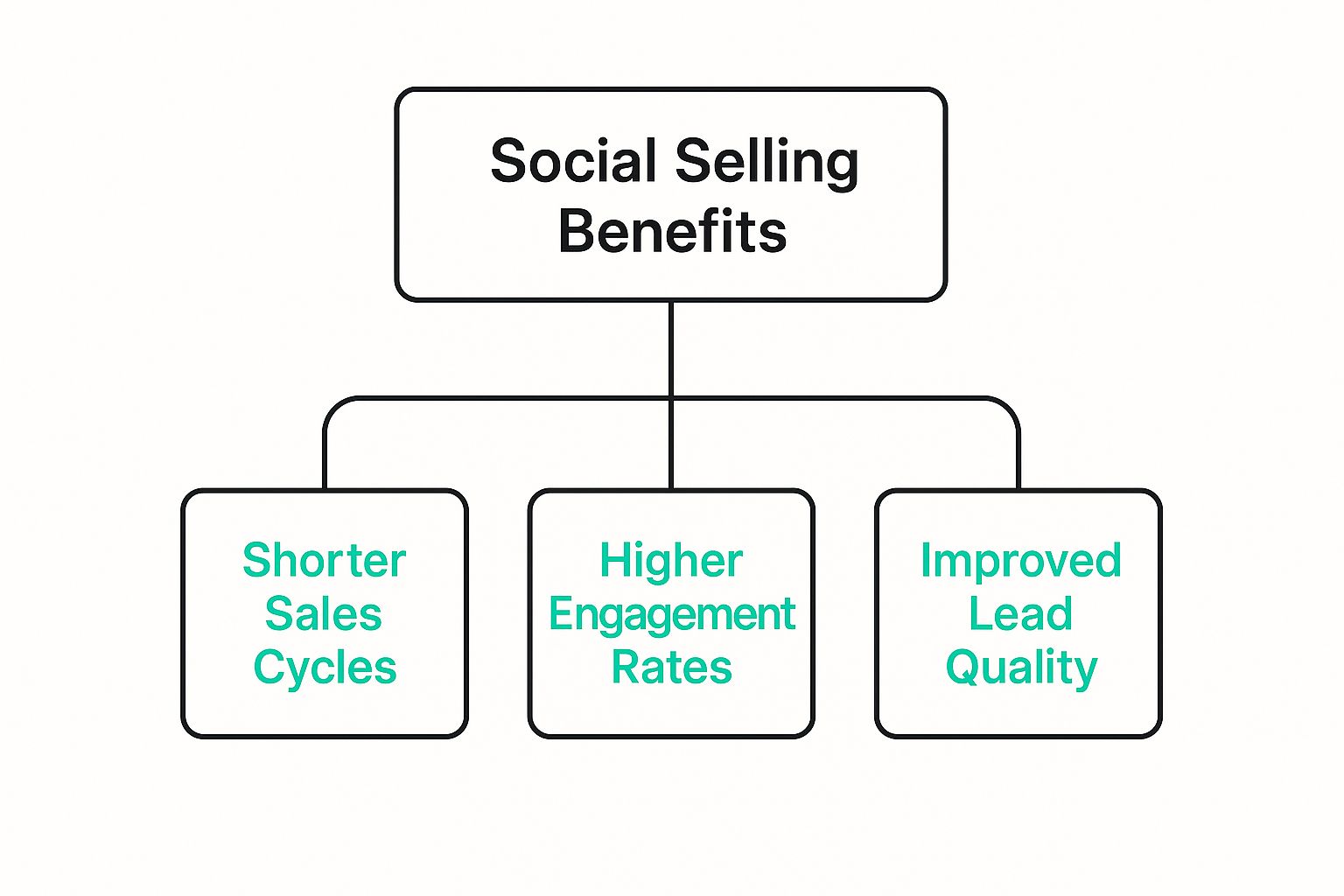What Is Social Selling and How Does It Work
Let's toss out the old playbook of cold calls and hard pitches for a minute. The real action today is happening online, right where your customers are, and it’s called social selling. This isn't about spamming inboxes; it's the art of listening, connecting, and helping long before you ever even think about asking for a sale.
What Social Selling Really Is

So, what is social selling when you get down to it? It’s a total mindset shift from interrupting people to engaging with them. Instead of pushing a product, you’re pulling prospects toward you by becoming a genuinely useful resource in their online world.
Think of it like this: you're at a big industry conference. You could run around shoving business cards into everyone's hands, or you could join a conversation, offer a helpful idea, and build a reputation as the person who really knows their stuff. Social selling is the digital version of being that expert in the room.
Moving From Pitching To Partnering
This whole approach is built on a foundation of value and being authentic. It's a long game that’s all about building relationships through small, consistent, and helpful interactions over time. The core moves look something like this:
- Sharing relevant content: Finding and passing along articles, studies, or insights that actually solve your audience’s problems.
- Jumping into discussions: Commenting on posts and participating in industry groups to show you know what you're talking about.
- Listening to the conversation: Keeping an eye on keywords and topics to understand what your prospects are really struggling with.
The magic of social selling is that you meet buyers on their own turf. You become a familiar, trusted name, making you the first person they think of when they finally realize they need help.
To really see the difference, let’s break down how this new approach stacks up against the old way of doing things.
Traditional Selling vs Social Selling At a Glance
| Aspect | Traditional Selling | Social Selling |
|---|---|---|
| Primary Goal | Close the deal as quickly as possible | Build a trusted relationship |
| Main Activity | Pitching products and features | Sharing valuable content and insights |
| Communication | One-way: sales rep to prospect (cold calls) | Two-way: engaging in conversations |
| Focus | On the salesperson and their quota | On the customer and their needs |
| Timing | Reaching out when the rep is ready | Engaging when the buyer shows interest |
This table makes it clear: one is a sprint to the finish line, and the other is a marathon focused on building a connection that lasts.
The Impact On Your Sales Funnel
This approach completely changes how you think about your sales funnel by nurturing prospects before they even know they're prospects. And the results speak for themselves. Companies that get social selling right often see nearly 60% higher revenue growth compared to those who don't. It's a clear signal that this method directly impacts the bottom line. You can find more data on social selling's effectiveness over at Salesgenie.
By building these connections before a need arises, you're organically warming up your leads. When it's finally time to reach out, it’s not a cold call anymore—it's just the next logical step in a conversation you've already started.
The Real Business Impact of Social Selling
So, what's the real payoff of social selling? It’s far more than just a new tactic to try—it’s a strategic shift that leads to tangible business growth. When you move past the theory, you start to see real results, from faster sales cycles to a pipeline full of better-quality leads.
The best-performing teams aren't just broadcasting; they're listening. They tap into online conversations to get real-time market intelligence, giving them a serious competitive advantage. This direct line to what your audience actually needs helps you sharpen your messaging and approach on the fly.
Simply put, a well-played social selling strategy shortens sales cycles, boosts engagement, and improves the quality of your leads.

This really shows how one benefit builds on the next. Better engagement naturally leads to better leads, which in turn helps you close deals faster.
Boost Brand Authority and Engagement
When you consistently share valuable content and jump into relevant discussions, you’re not just posting online. You're building a reputation as an expert—the go-to source in your field. This authority doesn't just get you more followers; it attracts high-intent prospects who already see you as a credible partner. It's a natural way to spark more meaningful conversations.
When you shift from pitching to educating, you're not just selling a product; you're building a reputation. This trust is the foundation for every future sales conversation and is a key driver of long-term customer loyalty.
This authentic engagement pays off. One report from Salesgenie found a 100% higher lead-to-close rate for social selling compared to traditional outbound methods. Numbers like that show that genuine engagement doesn't just fill your pipeline—it makes the entire sales process more effective.
Improve Lead Quality and Conversion
This approach also completely changes the quality of leads coming into your pipeline. Forget chasing down cold contacts who have never heard of you. Instead, you're connecting with people who have already signaled their interest in your industry or the problems you solve.
These warmer leads are usually more informed and much further along in their buying journey, which makes them far more likely to convert. For a deeper look at how to find these kinds of high-quality prospects, check out our beginner's guide to B2B lead generation.
The Four Pillars of a Winning Social Selling Strategy

A powerful social selling strategy doesn't just happen. It’s built on four interconnected pillars that work together, turning simple online interactions into real business opportunities. If you master each one, you create a repeatable process that actually gets results.
Think of this framework as a roadmap. It takes you from establishing your presence all the way to building lasting relationships. By focusing on these core areas, you can create a structured approach that feels authentic to you and your prospects.
1. Establish a Professional Brand
Your social media profile is your digital storefront. Before you even think about reaching out, you need to optimize it to pull in the right audience and build instant credibility. A half-baked or unprofessional profile can kill a conversation before it even starts.
Go beyond just listing your job title. Your profile should tell people what value you bring to the table and position you as a knowledgeable resource. This means a professional headshot, a compelling headline that speaks to your audience's problems, and an "About" section that tells your story. Building this brand is the first step in effective social media reputation monitoring, making sure prospects see you as a trusted advisor from the jump.
2. Find the Right People
Once your brand is sharp, the next pillar is finding your people. Social selling isn't about connecting with everyone; it’s about identifying and connecting with the specific decision-makers and influencers at your target accounts.
Get comfortable with the advanced search filters on platforms like LinkedIn. You can narrow down prospects by industry, role, company size, and a whole lot more. It’s also smart to set up alerts for trigger events, like job changes or company funding announcements, which signal the perfect time to reach out. A huge part of this is knowing how to effectively grow your LinkedIn network with the right contacts.
Social selling success isn't measured by the size of your network, but by the quality of your connections. Focus on building a curated list of relevant contacts who can benefit from your expertise.
3. Engage with Insights
This is where you start building trust. Instead of sliding into DMs with a sales pitch, you engage prospects by sharing valuable content and joining relevant conversations. The goal here is to become a recognized and helpful voice in your industry.
You can get there by:
- Sharing relevant content that actually helps your audience with their pain points.
- Commenting thoughtfully on posts from prospects and industry leaders—don't just say "great post!"
- Joining relevant groups to listen, learn, and contribute to discussions.
This consistent, value-first engagement makes you look like a helpful expert, not just another salesperson.
4. Build Strong Relationships
The final pillar is all about nurturing the connections you've made. This is where you move from public chats to one-on-one interactions that build rapport and uncover needs. It’s about turning a connection into a genuine professional relationship.
This means personalizing your outreach, mentioning shared interests or connections, and listening way more than you talk. Your goal is to guide the conversation naturally toward business when the timing feels right. When you do it well, moving from social media to a sales call feels like the next logical step for everyone.
Common Social Selling Mistakes to Avoid

Jumping into social selling is exciting, but it’s easy to trip over a few common hurdles. These missteps can kill a warm lead before a real conversation ever gets started, undoing all your hard work in a single click. Knowing what these pitfalls are is the first step toward building connections that actually last.
One of the biggest mistakes is treating social media like a personal billboard. Too many reps just blast out corporate content or brag about their latest win. This one-way street makes you look self-serving, not helpful, and it’s a surefire way to get ignored.
Another classic error? Sending a generic, copy-pasted sales pitch the second someone accepts your connection request. It’s the digital version of a cold call, and let’s be honest, it gets deleted almost every time.
The point of social selling isn’t to close a deal in your first message. It’s to open the door to a real conversation by showing your value and building a genuine relationship over time.
Instead of falling into these traps, it’s time to get a little more strategic and put the relationship first.
Forgetting to Listen First
Many salespeople are so eager to talk that they forget the most important part: listening. They dive into conversations without understanding the context or what their prospect is actually struggling with. When you do that, your input feels completely out of place and intrusive.
What to do instead:
- Monitor conversations: Keep an eye on keywords and discussions happening in your industry. This is how you’ll find out what your prospects really care about.
- Identify pain points: Pay close attention to the challenges and questions people are posting online before you ever think about offering a solution.
Neglecting Your Profile
Think of your social media profile as your digital first impression. If it’s incomplete, outdated, or just plain unprofessional, it torpedoes your credibility right from the start. It basically tells everyone you aren’t that invested in the platform or in presenting yourself as a serious professional. That’s a massive missed opportunity to build some foundational trust.
The Modern Tech Stack for Social Sellers
Trying to do social selling without the right tech is like trying to build a house with just a hammer. You might get something done, but it’s going to be slow, frustrating, and nowhere near as good as it could be. Today's most effective sales pros have a solid tech stack that turns their manual grind into a smart, scalable system.
These tools are the engines that power modern selling.
Start with the Right Foundation: LinkedIn Sales Navigator
For anyone serious about B2B social selling, the journey almost always starts with LinkedIn Sales Navigator. It takes the standard LinkedIn experience and puts it on steroids, giving you advanced search filters, smart lead recommendations, and real-time insights that let you find exactly who you’re looking for.
As you can see, the whole platform is built to help you zero in on key decision-makers and keep a close eye on company changes that signal an opportunity.
Building Out Your Toolkit
While Sales Navigator is a beast, it’s not the only tool you'll need. A truly powerful workflow pulls together a few different types of tools, creating a system that covers every angle of social selling. For instance, tools like Taplio for LinkedIn growth can seriously optimize your efforts on the platform.
Here's a quick look at the top tool categories you should be thinking about.
| Tool Category | Primary Function | Example Tools |
|---|---|---|
| Social Listening | Monitors online conversations for keywords and pain points. | Brand24, Mention |
| Content Curation | Finds trending, relevant content to share with your network. | BuzzSumo, Feedly |
| CRM & Integration | Manages relationships and syncs data across platforms. | HubSpot, Salesforce |
| AI Lead Generation | Identifies buying signals and high-intent prospects online. | Intently |
Putting these tools together gives you a complete system. You can listen for opportunities, share valuable content to build authority, and find high-intent leads automatically, all while keeping your relationships organized.
Let’s dig a little deeper into a few of these.
Key Tools Beyond the Basics
- Social Listening Platforms: Think of tools like Brand24 as your digital ears. They're constantly listening for keywords, mentions of your competitors, and industry pain points, giving you the perfect opening to jump into a conversation authentically.
- Content Curation Tools: Platforms such as BuzzSumo are fantastic for finding popular and relevant articles to share. This helps you keep your feed valuable and establishes you as a go-to resource in your space.
- AI-Powered Lead Generation: This is where things get really interesting. Modern platforms can automatically find high-intent conversations happening online right now. To see how it all works, check out our complete guide to AI lead generation tools.
Adopting these tools isn't just a nice-to-have; it's a competitive necessity. The right tech stack helps you work smarter, not just harder, by automating the grunt work of discovery so you can focus on what matters: building real relationships.
The numbers back this up. Around 71% of all sales professionals use social selling tools in their day-to-day, and that figure jumps to 90% for top-performing reps. It's clear that technology has become essential for driving real sales effectiveness in today's market.
Got Questions About Social Selling? We've Got Answers.
Jumping into any new sales strategy is going to bring up some questions. When it comes to social selling, a few of the same ones tend to pop up again and again. Let's clear the air so you can move forward and build a plan that actually works.
We’ll tackle some of the most common questions sales pros have when they first start weaving social selling into their day-to-day.
Social Selling vs. Social Media Marketing
It’s easy to get these two mixed up, but they’re playing completely different games.
Think of social media marketing as a billboard on the highway. It’s a one-to-many broadcast, all about building general brand awareness and casting a wide net. The brand is the hero.
Social selling, on the other hand, is like grabbing coffee with someone. It’s a one-to-one (or one-to-few) conversation focused on building a real, personal relationship with a specific prospect. The goal isn't just to be seen; it's to connect and guide that person on their buying journey.
What's the Best Social Selling Platform?
No surprise here: LinkedIn is the king of the B2B world because of its professional focus. But the real "best" platform is wherever your buyers are already hanging out and talking. Don't just guess—go find them.
- In the tech world, you'll often find decision-makers firing off real-time thoughts on X (formerly Twitter).
- For visual brands in wellness or design, Instagram is probably where the most meaningful connections are being made.
- In niche B2B industries, the gold is often buried in specialized forums or industry-specific groups.
The right platform is the one that gets you a seat at the table where your ideal customers are already having conversations.
Social selling isn't about shouting from every rooftop; it's about being present and genuinely helpful on the right platforms. Put your energy where your buyers are, and you’ll build connections that matter.
How Long Does This Actually Take?
This is the big one, so let’s set the expectation right now: social selling is a long game. It's a marathon, not a sprint. The whole approach is built on earning trust and establishing yourself as a credible resource, and that just doesn't happen overnight.
You might see some early signs of life—likes, comments, new followers—within a few weeks, which is great. But don’t expect a sudden flood of leads. It usually takes several months of consistent, valuable interaction before you start seeing a reliable pipeline of opportunities. Patience is your best friend here.
Ready to stop guessing and start finding high-intent leads? Intently uses AI to monitor online conversations and alerts you to prospects who are actively looking for solutions right now. Discover your next customer.
